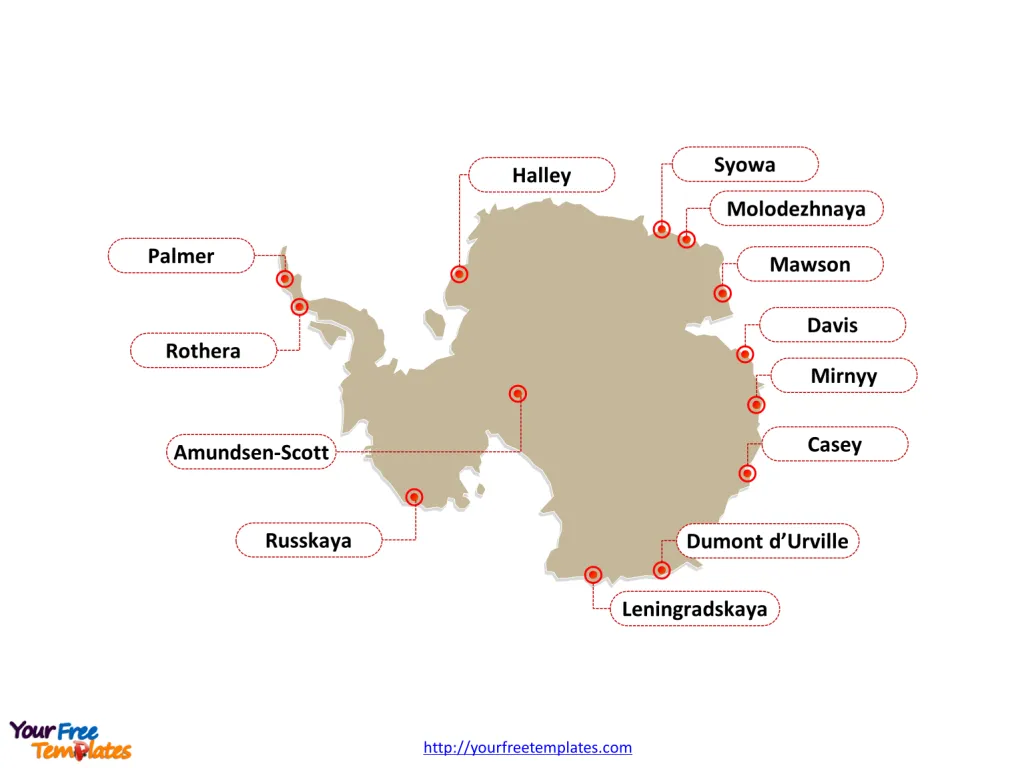The Antarctica Map Template includes two slides. Antarctica map with two slides, one with the outline boundary and the other with major stations.
Antarctica is located at the southernmost tip of the Earth, encompassing the continent itself and the surrounding Southern Ocean. It is situated almost entirely within the Antarctic Circle and is characterized by its extreme cold, vast ice sheets, and unique ecosystem.
Population Antarctica has no indigenous population and is not permanently inhabited by humans. However, it does host a fluctuating population of scientists, researchers, and support staff from various countries who reside in research stations across the continent. The population typically ranges from 1,000 to 5,000 people during the summer months and significantly decreases during the harsh winter.
Economy Antarctica is not a site for traditional economic activities such as agriculture or manufacturing. The Antarctic Treaty System, which designates Antarctica as a scientific preserve, prohibits commercial mineral mining and other industrial activities. Instead, the continent’s economy revolves around scientific research, environmental conservation, and eco-tourism, with some countries operating research stations and supporting logistical services.
Slide 1, Antarctica map of outline
Antarctica is Earth’s southernmost continent, together with Africa, Asia, Australia/Oceania, Europe, North America, and South America to constitute the seven continents in the world. New Zealand and Chile are the close countries to this continent.
Importance Antarctica holds immense scientific, environmental, and geopolitical importance. It serves as a critical platform for studying climate change, glaciology, astronomy, and biodiversity. The continent’s ice sheets and glaciers also play a crucial role in regulating global sea levels. Furthermore, Antarctica is a repository for valuable information about Earth’s past and a unique habitat for various species adapted to the extreme conditions.
Geopolitically, the Antarctic Treaty System, which designates the continent as a scientific preserve, has successfully maintained peace and cooperation among signatory countries and established a framework for international collaboration in scientific research and environmental protection. The region’s significance as a natural laboratory and its potential impact on global climate patterns make it a focus of continued scientific inquiry and international cooperation.

Slide 2, Antarctica map labeled with major stations.
There are 31 countries have established permanent research stations in Antarctica and signed the Antarctica Treaty. They are Argentina, Australia, Belarus, Belgium, Brazil, Bulgaria, Chile, China, Czech Republic, Ecuador, Finland, France, Germany, India, Italy, Japan, New Zealand, Norway, Pakistan, Peru, Poland, Romania, Russia, South Africa, South Korea, Spain, Sweden, Ukraine, United Kingdom, United States, and Uruguay.
Antarctica hosts several major research stations that serve as vital hubs for scientific exploration and collaboration.
- The U.S. maintains three year-round research stations in Antarctica: McMurdo Station on Ross Island, Amundsen-Scott South Pole Station at the geographic South Pole, and Palmer Station on Anvers Island in the Antarctic Peninsula region.
- These stations support a wide range of scientific research, including studies of the region’s ecosystems, its impact on global processes such as climate, and upper atmospheric and space research.
- The National Science Foundation (NSF) funds and manages the U.S. Antarctic Program, which supports the nation’s goals of promoting the Antarctic Treaty, fostering international cooperation in research, protecting the Antarctic environment, and ensuring the equitable and wise use of resources.
- The research conducted at these stations contributes to a better understanding of Antarctica’s significance in global processes and the unique challenges of its extreme environment.

The Antarctic Treaty, signed in 1959, plays a crucial role in governing international activities in Antarctica. It designates Antarctica for peaceful purposes and scientific investigation, promotes the free exchange of scientific data, and prohibits military use and nuclear testing. The Treaty also stipulates that all activities in Antarctica must be conducted with minimal environmental impact.
Furthermore, the Treaty has established a framework for international collaboration in scientific research, environmental protection, and the management of specific areas within the continent. Its provisions ensure that Antarctica remains a global commons for peaceful scientific exploration, environmental preservation, and international cooperation.
The Treaty’s significance lies in its role as a model of international cooperation and environmental protection, making it a cornerstone of peaceful scientific research and environmental stewardship in Antarctica.
Looking for Premium maps, please visit our affiliate site: https://editablemaps.com/ or https://ofomaps.com/
Size: 68K
Type: PPTX
Aspect Ratio: Standard 4:3
Click the blue button to download it.
Download the 4:3 Template
Aspect Ratio: Widescreen 16:9
Click the green button to download it.
Download the 16:9 Template











